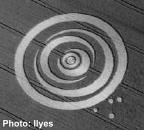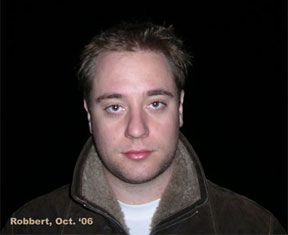 |
| Robbert
van den Broeke – October, 2006
Photo: Nancy Talbott |
|
March, 2012 -- UPDATE
Part 1 of this report includes Robbert's discovery in 2006 that he was able (like Uri Geller and others) to bend cutlery and cause compass needles to spin and also to cause metal objects to stick to his body
-- simply by focusing his intent upon doing these things.
In 2006 Robbert thought it was OK that we make public the fact that he had discovered he could do these things, but he now feels these "abilities" are not very important. Also, he does not want to confuse readers who might wonder if he is using sleight-of-hand or other tricks used by illusionists who appear to be doing these same things -- because he is not.
In Robbert's case these abilities are related solely to the "energies" which work through him when he opens himself to their presence & then focuses his attention on one "task" or another.
|
Robbert van den Broeke is a remarkable young man who lives in the
small rural village of Hoeven, in southern Holland. He first came
to my attention in 1996 when he was about 16, because of a report
from one of the BLT Research Team's colleagues in the Netherlands
that a young boy there had witnessed light-balls and an "angel"
which emerged from one of them at a crop circle site in the fields
around Hoeven. I thought this was curious, but didn't take the report
too seriously at the time.
The following year BLT was again contacted about this same boy who
had, on August 2, 1997, along with his younger sister Madelon, witnessed
a large, very bright, rotating light-ball right outside his bedroom
which, when it disappeared, had left burn marks on the exterior
wood trim and a strange white powder on the small balcony floor
outside the bedroom. The burn marks, which were clear but not extensive,
occurred both on the overhanging wooden eaves of the roof and on
the outside of the balcony doors. Also, the metal roof of a birdhouse
attached to the side of the home just below the balcony had also
apparently been affected, with burn marks along its edges. Robbert's
parents were quite concerned, and we were asked if BLT scientists
could carry out an analysis of the white material.
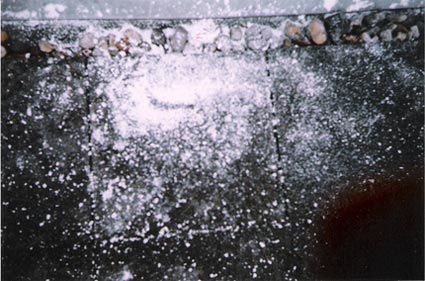 |
| White
powder found on August 2, 1997 on Robbert's balcony floor
following the presence of a "large, very bright" rotating
light-ball.
Photo: R.v/d Broeke |
Since
Robbert had by now begun also to report "dreams" and other
strange experiences to his parents -- during which he would often
"know" (accurately) that a new crop circle was forming
in the Hoeven area -- we felt that a closer look at his situation
might provide information regarding our primary focus of interest
(the crop circle phenomenon), and so we agreed.
Utilizing
EDS (electron dispersive spectroscopy) we were able to determine
that the white powder sample presented predominant amounts of magnesium
and oxygen, some carbon and a trace amount of calcium. Subsequent
IR (infra-red spectroscopy), carried out by analytical chemist Phyllis
Budinger, confirmed the EDS results--further identifying the white
powder as "basic magnesium carbonate," with possible trace
amounts of calcium carbonate also present. The material's most unusual
characteristic was the level of purity of the sample.
Why
very pure magnesium carbonate would be left on Robbert's balcony
following the presence of the ball of light is unknown. It is of
interest that this material is often used in fire-proofing agents
and for heat insulation.
The
following year I met Robbert and his parents at a lecture I presented
in Amsterdam and, since then, the v/d Broekes and I have become
friends. For 10 years now (Robbert is now 27 years old) I have visited
them repeatedly, staying in their home for several weeks on each
occasion, and have personally now witnessed a wide range of indisputably
strange events which constantly occur around Robbert--including
my direct observation of two crop circles forming see:
www.bltresearch.com/eyewitness/eyewitness1.php
www.bltresearch.com/eyewitness/eyewitness4.php
Over
the years the unusual phenomena around Robbert have increased and
he is now known in Holland as a "medium," someone with
extraordinary psychic talent. His ability to perceive aspects of
reality unavailable to most of us is valued in the Netherlands,
and he is taken quite seriously by many people there. Recently he
has told me about an increasing ability to affect physical objects,
which he thinks is related to intense focusing of his attention
(a capability he believes is latent in many people) and, so, when
I visited him in October, 2006, I documented and tried to photograph
clearly some of Robbert's more recent capabilities to effect physical
matter.
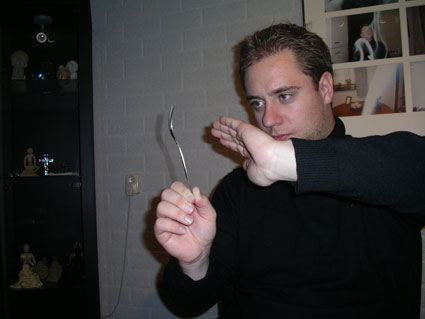 |
| Robbert
beginning to focus attention on one of
the stainless-steel kitchen forks.
Photo: N.Talbott, 2006 |
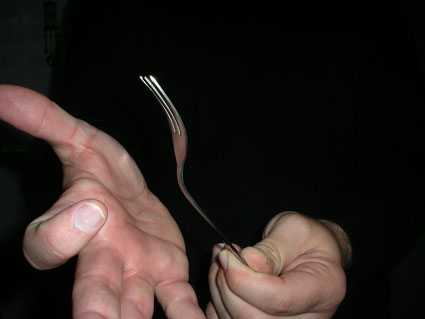 |
| The
fork begins to bend. While taking this close-up from about
1 ft. away, my camera became quite hot, forcing me to move
back.
Photo: N. Talbott, 2006. |
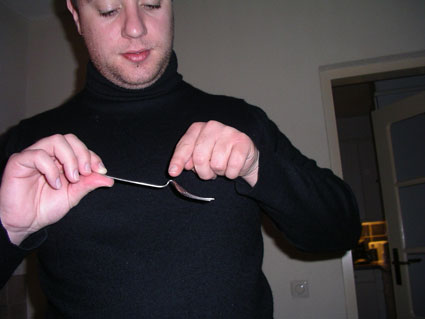 |
| Robbert
continues to direct mental "energy" toward the fork. He
does not touch the fork at any time during the 2-5 min.
process.
Photo: N. Talbott, 2006. |
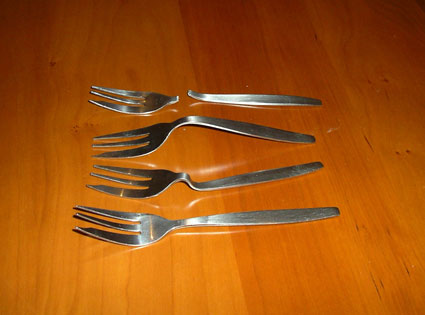 |
| "Control"
fork (kept in separate room & not exposed to Robbert's concentration)
at front; three others subjected to Robbert's focused attention.
Photo: N. Talbott, 2006. |
As I had stood closer and closer to Robbert during this exercise
(in an attempt to get as good a photograph as possible) I began
to recognize that the front of the camera was getting hot —
there was also enough heat on my face and on the hand holding the
camera, to force me to instinctively step back. Robbert's intense
concentration was somehow generating real heat as the fork began
to soften and bend. We repeated the exercise many times so I could
get clear photos and, by the end of that night, most of Mrs. v/d
Broeke's stainless steel kitchen forks were ruined and we had to
buy her a new set.
It
is widely known that other people possess this ability to bend metal
objects — most notably, perhaps, Israel's psychic Uri Geller
who became a household name during the 1960s and '70s. Perhaps less
well-known is the fact that Geller also had encounters with light
balls, beginning at the age of 4 (about the same time that Robbert's
parents began to notice unusual behavior in their young son), and
that serious scientific research into some of Geller's abilities
was conducted by Drs. Russell Targ and Hal Putoff at California's
famous Stanford Research Institute -- the results of which
were reported in a paper published on October 18, 1974 in the British
science journal Nature (vol. 251, pp.
602-607).
Interestingly,
the editors of Nature, in preliminary
comments (see p. 559) regarding their decision to publish this "high-risk"
paper, stated that they were "convinced… [that]…
standard magical tricks" were not
involved in the incidents reported upon by Targ and Putoff
and, further, that the scientific community had now (because of
this paper) been "put on notice that there is something worthy
of their attention and scrutiny in the possibilities of extra-sensory
perception." Another of the significant preliminary remarks
made by Nature's editors raises the pertinent
question as to whether--or if--science had yet developed the "competence
to confront claims of the paranormal" (read the full text at:
http://www.uri-geller.com/content/research/nature.htm.
Indeed, this is a relevant question today, 33 years later.
Geller
participated in a number of other scientific inquiries, notably
in controlled laboratory experiments in 1998 with famed British
physicist, Brian Josephson, winner of the Nobel Prize for physics
in 1973. Dr. Josephson's results were described in The Geller
Papers (1975, The Houghton-Mifflin Co.), edited by Newsweek
science writer Charles Panati.
Although
I was not previously acquainted with Uri Geller's history and thought
that another relatively recent development in Robbert's case was
unique, reading through the Geller literature now I find that this
is not the case. Geller is reported to have also been able to influence
compass needles, apparently in a similar manner to that which I
witnessed in Hoeven with Robbert in October, 2006. Over a period
of approximately 3-4 minutes Robbert would intensify his concentration
and focus on the compass. In the beginning he would clench one hand
into a fist, bringing his fist within 8-10 inches of the compass,
which seemed to cause the needle to deviate slowly to the West;
then, once the needle had begun to move, Robbert was able to remove
his hands from close proximity and simply "hold" the needle
in position with his mind. This effect would last for as long as
Robbert desired.
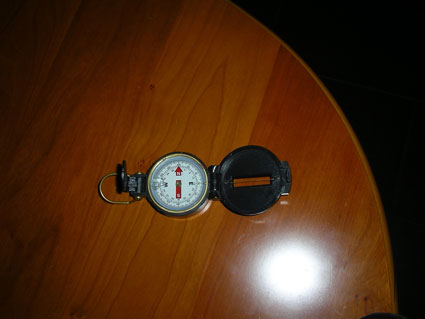 |
| Compass
is functioning normally, with needle pointing North,
prior to any attempt by Robbert to influence it.
Photo: N.Talbott, 2006. |
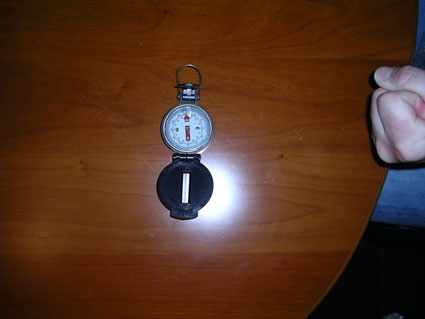 |
| During
initial minutes of concentration, Robbert clenches his fist
to help focus energy. Needle has just begun to move.
Photo: N.Talbott, 2006. |
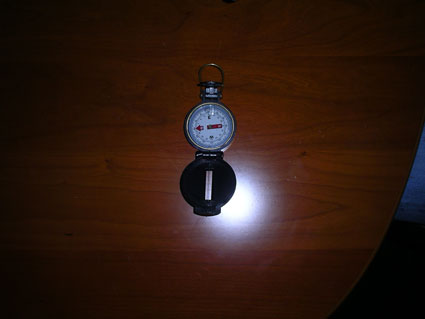 |
| 3-4
minutes into the exercise, needle is now pointing West and
Robbert has removed his hands from the table.
Photo: N.Talbott, 2006. |
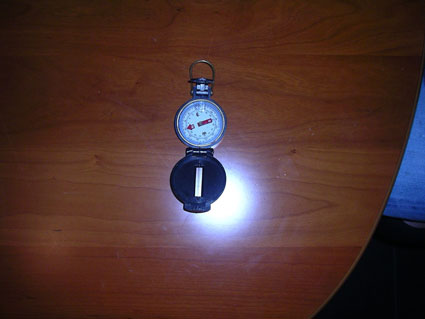 |
| As
Robbert continues to focus over another minute or so,
the needle moves about five degrees more.
Photo: N.Talbott, 2006. |
The
blue on the right of the photos above is the leg of Robbert's jeans.
He sat at the desk throughout this exercise, leaning in toward the
compass as he began focussing his attention and then, as the needle
began to move in whichever direction he desired, pulling his body
back into the chair, with his hands just resting in his lap. It
seemed that he used his hands only in the beginning of the effort,
never touching the compass at any time and never bringing them any
closer than is documented in these photos.
I noticed that when he wanted to pull the needle toward him (to
the East) he used both hands for awhile, one partially clenched
and the other open as if "directing" the energy, which
he was somehow concentrating or intensifying in his other hand.
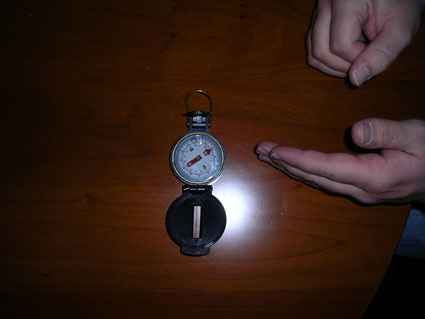 |
| Robbert,
now focused on pulling the compass needle toward him,
uses both hands for awhile.
Photo: N.Talbott, 2006. |
Robbert
and I spent one whole night, for several hours, also repeating this
exercise over and over so that I could get decent photographs. As
his witness in this instance I am certain that there was nothing
physical (no magnetic source) underneath the wooden desk-top which
could have influenced the compass needle--nor anything at all in
Robbert's hands or on his person, or in the room itself, that could
have played a role.
Although
I have known him now for 10 years — and witnessed many amazing
things in his company — I continue to take seriously both
his efforts and mine in documenting these events. And I continue
to observe no indication of confabulation or deceit.
During
this October, 2006 visit Robbert agreed to demonstrate another effect
he's recently discovered he can exert on ordinary matter —
again using some of his mother's stainless-steel dinner forks and
several large, heavy (3 ounces, or 86 grams each) stainless-steel
serving spoons. [Stainless steel is non-magnetic and, although it's
clear to me that ordinary magnetism is not involved here, I did
check the cutlery with a strong magnet anyway to be certain that
these forks and spoons were not somehow magnetized.]
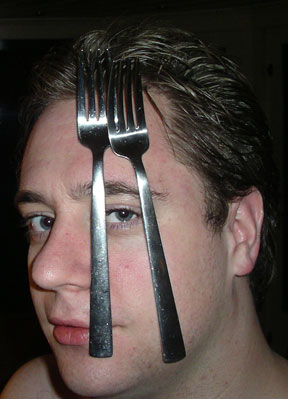 |
| Once
Robbert has established the necessary focus, stainless steel
forks stay on his head. He can move around and even hold
a conversation--the cutlery will not fall.
Photo: N. Talbott, 2006 |
I
gathered the forks and spoons from the kitchen drawer and checked
each of them to be sure they were clean, with no adhesive of any
kind. We began with the less heavy forks. Robbert closed his eyes
and concentrated for a few minutes before asking me to hand him
first one, then another, and then another. It took about 5 minutes
of concentration before he was able to make the first fork stay
on his forehead, but once this was accomplished it took much less
time for him to add on the others.
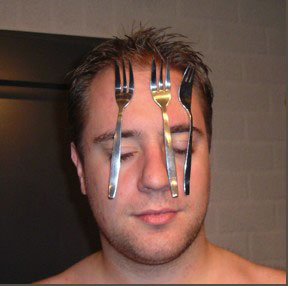 |
| Robbert
after about 12 minutes of concentratiion. Forks stayed on
his forehead for up to 10 minutes/trial.
Photo: N.Talbott, 2006. |
Soon he was adding forks to his chest and, while I watched, he was
eventually able to keep 5 forks simultaneously "stuck"
to both his chest and forehead for several minutes at a time. Although
he had begun with his eyes closed, clearly focusing his mind intently,
I was extremely impressed when only 15-20 minutes into the demonstration
he opened his eyes and we carried on a conversation — with
the forks staying exactly where he had placed them on his body.
He
was able to walk all around the downstairs, from room to room for
5-10 minutes each time, and even laughed when I said something funny.
It was amazing to me that he could keep the forks "stuck"
to him as if glued for such long periods of time while his attention
— or at least part of it — was involved in interacting
in a totally coherent, conscious manner, with me.
Several
times during this evening, after he had mentally "released"
the cutlery and it would fall to the floor, I picked up the same
forks and/or spoons he had been using and tried to make them stick
to my head. Sometimes when I've been around Robbert for awhile I
have the feeling that maybe I can learn to do these things if I
try hard enough — but, so far, no luck. In my case, the forks
just fell to the floor each time I tried.
Next
Robbert started adding the much heavier spoons. As I handed the
first one to him it was clear that again, at first, he had to focus
his attention intently to keep the 3 oz. spoons from falling.
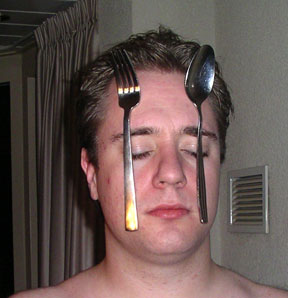 |
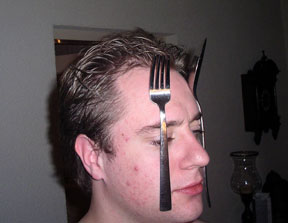 |
| Robbert
concentrating as he begins to
use the heavier 3 ounce spoons.
Photo: N.Talbott, 2006 |
We
spent one whole evening on this exercise and it was my impression
that, on some level, Robbert had to expend more effort than he had
during our previous evenings' demonstrations. Sometimes, if his
focus was broken for some reason, the spoons/forks would fall to
the floor. I took these opportunities to again check them for adhesive,
but they were always as clean as when I had originally handed them
to him.
Also
perspiration was not a factor, as he did not noticeably perspire
at all during the exercise. He did slap the spoons onto his chest
fairly vigorously in the beginning, causing red marks to appear,
but the skin in these areas was never wet. And after awhile he was
able to simply place the spoons wherever he wanted, with no force
at all.
Over
a period of several hours we repeated the exercise so I could get
many photographs. Robbert did seem to tire after an hour or two
and, although we both enjoyed getting this new capability documented
to some extent — and we both realize this new talent is indicative
of Robbert's increasing capabilities — we were getting bored
with what seems in some ways to be a frivolous exercise. Given the
problems facing mankind, the value of being able to stick stainless
steel objects to your body seems obscure. We both wish we understood
better what these abilities portend and knew how they might be applied
more usefully.
Having
been right there I can come to only one conclusion: Robbert has
developed an ability to manifest his intent/will upon our normal
physical reality in a way that defies current understanding. And
it is also clear to me, having known him for so long, that this
ability is increasing as the years go by, and he continues to expend
effort in this direction. It seems to me that whether one calls
this a "psychic" phenomenon or a "spiritual"
one, or thinks of it simply as a significant extension of "normal"
human consciousness, terminology is not the major issue here. What
is actually occurring — and how and why it is occurring — is what
is important. I assume that all thoughtful people, and perhaps most
particularly those with extensive scientific training, would find
such events of genuine interest. After all, it is well-known that
it is in the anomalies of nature where
the greatest clues to the as-yet-unknown are likely to be found.
Continue
to Part 2 > >
©
2007 BLT Reseach Team Inc.
All Rights Reserved
Photos/Illustrations can not be reproduced in any media except
with written permission from the photographer or illustrator |
|

